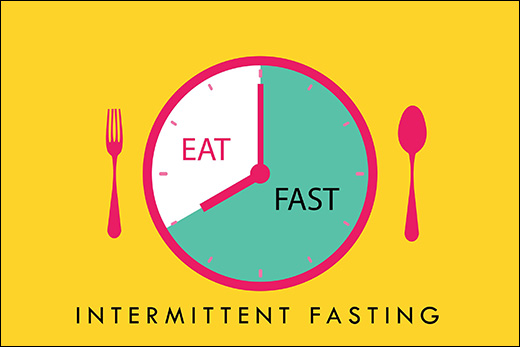Intermittent Fasting For Vata, Pitta And Kapha Types
Abstract
Intermittent fasting (IF) has gained global popularity as an effective method for weight loss, improving metabolic health, and promoting health in the long run. It is known for its structured periods of eating and fasting, which help the body rest, repair, and reset. In Ayurveda, the effectiveness of any diet or fasting regimen should be personalized to every person’s unique constitution or "Prakriti" (Body type). Ayurveda says that our body consists of three doshas that are Vata, Pitta and Kapha. The combination and balance of these three doshas will decide our prakriti (Body type). Each individual has presence of all the three doshas but there is dominance of either one or two doshas in person, and sometimes all three doshas are present in equilibrium.

Introduction
Intermittent fasting is like a metabolic switch between fasting and eating states. While fasting it is likely to fast for about 12, 14, 16, 18 or maybe 20 hours then have a window period for eating wholesome meals. During the fasting period, the calorie intake is either zero or limited to 500 calories only and then the person eats only in the eating window. In the fasting period, only liquids are taken if necessary. The solids are only consumed in the eating window. The longer periods of fasting and reduced calorie intake forces the body to shift its energy sources from regular incoming meals to fat stores in the body. This causes fat mobilization and release of ketone body energy. Also, the longer periods of fasting activates the body’s defence mechanisms and autophagy against the oxidative stress and the metabolic stress of the body which ultimately suppresses the inflammation in the body and promotes weight loss.
Intermittent Fasting In Ayurveda
According to Ayurveda, langhan is one of the major lines of treatments in Santarpana Janya vyadhi (metabolic diseases), which is explained by the Acharya Charaka (father of medicines in Ayurveda). Langhan in simple terms is something which causes lightness in our body. There are 10 types of langhan among which “Upwasa” (fasting) relates to the concept of intermittent fasting most. Upwasa (fasting) is a complete or partial restriction of our diet. Our digestive system is always busy dealing with the incoming meals and digesting it. By practicing Langhan, our body gets a chance to reduce the accumulated doshas and reinstates the balance between them. Keeping the body in state of “upwasa” instigates the Agni (metabolic fire). The strong Agni helps in “ama pachana” i.e., digestion of the accumulated toxins which further opens up all the srotas (minute body channels) improving microcirculation. Upwasa (fasting) is indicated in people having “Alpa bala” (individuals with lesser strength), for their metabolism related concerns.
Intermittent Fasting In Vata Prakriti
Vata Prakriti people are generally light, energetic, and creative, but they are also prone to anxiety, restlessness, and dryness. Vata types tend to have a variable appetite and irregular digestion (Visham Agni), therefore have irregular hunger patterns. Due to their high-energy nature, Vata people have a tendency to skip meals or go long periods without eating, which can further disrupt their digestion and cause dehydration. They are also prone to feeling cold and dry, which can be aggravated by long periods of fasting without proper nourishment. They are often quick to lose weight but may also have trouble maintaining it. Intermittent fasting is not usually recommended in vata prakriti people as it can further increase the vata dosha more in them.
Ideal Fasting Period
A Vata-friendly intermittent fasting schedule would include a 12-hour fasting window (e.g., 7 pm to 7 am) followed by a 12-hour eating window. Meals should be rich in nourishing, hydrating, and warming foods to maintain balance.
Considerations In Vata Prakriti
- Avoid Overstretching the Fast: as prolonged periods can increase dryness, fatigue.
- Warm, Moist Meals: are advised to balance the dry and cool qualities of vata and to maintain weight.
- Consistency in Eating Schedule: to prevent irregular hunger patterns.
Vata Balancing Food
While fasting vata people should include food items like cow’s ghee, warm milk, bananas, avocado, sesame seeds, coconut oil, mangoes, carrots, pumpkin, sweet fruits, papaya, dates, fresh veggies, sweet potatoes, oats, etc.
Intermittent Fasting In Pitta Prakriti
Pitta is made up of Agni (fire) and Jal (water) mahabhuta (elements). They have a strong appetite and a powerful digestive fire (Teekshna Agni), which allows them to process food quickly. However, they can be prone to irritability, acidity, and inflammation when their Pitta is out of balance. Pitta types maintain a moderate weight but can struggle with weight gain during times of stress or excess heat. They can tolerate longer fasting periods when compared to Vata types, as their strong digestion allows them to handle more extended periods without food.
Ideal Fasting Period
A Pitta-friendly intermittent fasting pattern would involve a 14-16 hour fasting window (e.g., 6 pm to 10 am) followed by a 10-8 hour eating window. Focus on cooling, hydrating foods and beverages to prevent overheating and acidity.
Considerations In Pitta Prakriti
- Take cooling foods to balance the agni (digestive fire) while fasting
- Take meals at a regular period to prevent overheating
- Stay hydrated
- Fast during the cooler hours of days
Pitta Balancing Food
While fasting pitta people should include food items like coconut water, cucumbers, cantaloupes, watermelons, fresh mint, fresh yogurt, rice, cow’s milk, coconut milk, bananas, pomegranate, cow’s ghee, cabbage, aloe vera juice, mangoes, cardamom, leafy greens etc.
Intermittent Fasting In Kapha Prakriti
Kapha is primarily composed of prithvi (earth) and jal (water) mahabhuta (elements). People with a Kapha constitution tend to be calm, grounded, and steady, with a naturally strong and stable body. They have a manda Agni (slower metabolism) and can easily gain weight. Kapha types benefit from stimulation and movement to keep their energy levels high and prevent feelings of heaviness. They benefit from intermittent fasting, as it helps to stimulate metabolism and promote detoxification. However, it is important for Kapha types to avoid extreme fasting schedules that might lead to fatigue or overwhelm.
Ideal Fasting Period
A Kapha-friendly intermittent fasting schedule would involve a 16-18 hour fasting period (e.g., 8 pm to 12 pm) followed by an 8-6 hour eating window. Focus on lighter, spicier foods and engage in regular physical activity to maintain energy levels and prevent sluggishness.
Considerations In Kapha Prakriti
- Try longer fasting periods to increase Agni.
- Stimulate digestion with spices
- Eat light and energizing foods
- Encourage movement during the fasting period
Kapha Balancing Food
While fasting kapha people should include food items like ginger, garlic, peppers, honey, leafy greens, cauliflower, broccoli, pumpkin, mung dal, fresh seasonal veggies, pineapple, pear, papaya, peas, beetroot, radish, carrots, etc.
Benefits Of Intermittent Fasting
- Helps in weight loss
- Improves insulin sensitivity
- Reduces inflammation in the body
- Decreases risk of cardio-vascular diseases
- Improves metabolism
- Improved brain functioning
Contraindications In Intermittent Fasting
- Type 1 diabetes mellitus: Longer fasting periods can lead to hypoglycemia which can get fatal.
- Pregnant or lactating mothers.
- Patients of Chronic Kidney Disease, chronic liver disease, or any other life-threatening conditions.
- Young children and teenagers: as it is the growth phase of life and IF can disrupt the growth of these individuals.
- Aged and frail adults.
- People with any eating disorders.
- People with immunodeficiencies.
Conclusion
Intermittent fasting can be a highly effective tool for health and wellness, but its success depends on the alignment with an individual’s unique dosha. For Vata types, fasting should be gentle and supportive with nourishing, warm foods and a balanced schedule. Pitta types can tolerate longer fasts but should focus on cooling, hydrating foods and avoiding excessive heat. Kapha types benefit from longer fasting windows to stimulate metabolism and should focus on lighter, spicier foods while incorporating physical activity. By honoring our Prakriti and customizing our intermittent fasting routine accordingly, we can unlock the potential for improved health, vitality, and balance. Ayurveda emphasizes that health is a result of balance between mind, body, and spirit, and this balance can be disrupted if the fasting schedule is not aligned with one’s natural constitution i.e., prakriti.



